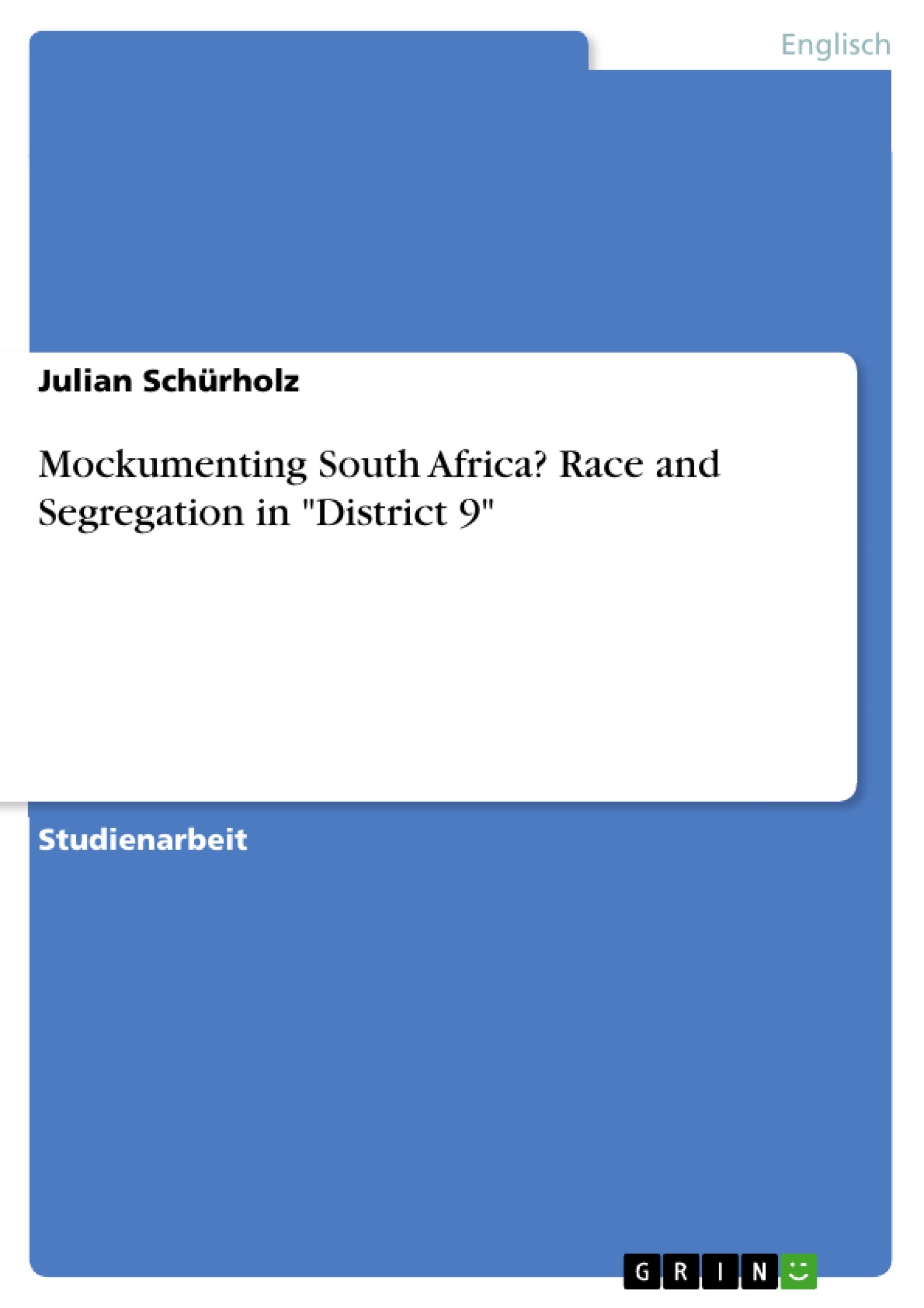“District 9”, one of the movie blockbusters of 2009, was directed and co-written by Neill Blomkamp, produced by Peter Jackson, and is nominated for four Oscars (cf. IMDb). It is a documentary-style fiction movie whose story revolves around a (para-)military relocation operation of over one million aliens, who have been living in a hermetically sealed off slum near the South African city of Johannesburg since the early 1980s. Tensions arose between the human and the alien population, ultimately leading to the relocation operation. The leader of the operation is Wikus van de Merwe, a naïve white-collar worker, who, in the course of the movie, accidentally infects himself with a virus that slowly turns him into an alien.
Considering the real-world history of the movie’s setting, thrilling similarities between events during the time of the South African Apartheid regime and the story of District 9 catch one’s eye. The most blatant one is the forced relocation of around 60,000 people from the Sixth Municipal District of Cape Town in the course of a large-scale government program to segregate South African society by assigning a certain area of the country exclusively to one specific ethnic group. Moreover, the major “player” in the story of District 9 is the private security firm MNU, which also finds its counterpart in recent South African history.
Through large parts of the movie, District 9 pretends to be a patchwork of media edited into a documentary. This paper will deal with the question of whether “District 9” is a mockumentary about real-life South Africa, especially Cape Town’s District Six.
The first part of this paper will focus on content and give a rough outline of the most important historic events in South Africa and specifically in District Six. Then, the parallels to these events as depicted in District will be put on display. Secondly, this paper will turn to examining form and display typical characteristics of mockumentaries. This will necessarily involve the examination of what defines documentary as a genre. As a next step, this paper will try to find examples of these characteristics in District 9. Eventually, this paper will answer the question of whether or not District 9 is a mockumentary about South Africa and District 6.
Inhaltsverzeichnis
- A) What, Why, How?
- B) What Factual Similarities Are There
- Between District Six (and South Africa in General)...
- ...and District 9?
- C) What is a "Mockumentary"?
- D) What "Realist Artifice" Can Be Found in District 9?
- E) What Degree of Mockumentary Is District 9?
- F) Works Cited
Zielsetzung und Themenschwerpunkte
Diese Arbeit untersucht den Film "District 9" (2009) von Neill Blomkamp und stellt die Frage, ob es sich bei dem Film um eine Mockumentary über das reale Südafrika, insbesondere über Kapstadts District Six, handelt. Die Arbeit analysiert zunächst die Parallelen zwischen den realen Ereignissen während der Apartheid in Südafrika und den fiktiven Ereignissen im Film, insbesondere die erzwungene Umsiedlung der Bewohner von District Six und die Entstehung von Slumgebieten. Anschließend wird der Begriff der Mockumentary beleuchtet und anhand von filmischen Merkmalen analysiert, inwieweit "District 9" diese Eigenschaften aufweist.
- Parallelen zwischen der Apartheid in Südafrika und den Ereignissen in "District 9"
- Analyse der Mockumentary-Elemente in "District 9"
- Untersuchung der Frage, ob "District 9" als Mockumentary über Südafrika verstanden werden kann
- Analyse der filmischen Gestaltung und der Verwendung von realistischen Elementen in "District 9"
- Die Rolle von Rassismus und Diskriminierung im Kontext von "District 9"
Zusammenfassung der Kapitel
Der erste Teil der Arbeit beleuchtet die historischen Ereignisse in Südafrika und insbesondere in District Six, die als Grundlage für die Darstellung im Film dienen. Es werden die wichtigsten legislativen Maßnahmen der Apartheid-Regierung und deren Folgen für die Bevölkerung, insbesondere die erzwungene Umsiedlung der Bewohner von District Six, beschrieben. Der zweite Teil der Arbeit widmet sich der Analyse des Genres der Mockumentary. Hierbei wird untersucht, was Dokumentarfilme ausmacht und welche filmischen Merkmale typisch für Mockumentaries sind. Der dritte Teil der Arbeit untersucht, ob "District 9" die Merkmale einer Mockumentary aufweist und inwiefern der Film als Kommentar zur realen Situation in Südafrika interpretiert werden kann.
Schlüsselwörter
Die Arbeit beschäftigt sich mit den Themen Apartheid, Rassismus, Diskriminierung, Segregation, Mockumentary, "District 9", Südafrika, Kapstadt, District Six, Slum, Umsiedlung, Alien, Film, Filmtheorie, Filmgeschichte.
- Quote paper
- Julian Schürholz (Author), 2010, Mockumenting South Africa? Race and Segregation in "District 9", Munich, GRIN Verlag, https://www.grin.com/document/154658



